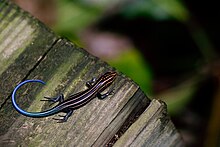Plestiodon
| Plestiodon | |
|---|---|
 |
|
| Plestiodon fasciatus | |
| Scientific classification | |
| Kingdom: | Animalia |
| Phylum: | Chordata |
| Class: | Reptilia |
| Order: | Squamata |
| Family: | Scincidae |
| Genus: |
Plestiodon A.M.C. Duméril & Bibron, 1839 |
Plestiodon is the name for a genus of lizards formerly referred to as Eumeces, except those now placed in Mesoscincus.
The genus Plestiodon are skinks (family Scincidae). They are secretive, agile animals with a cylindrical body covered with smooth, shiny scales.
The common name for these lizards with a blue tail is the common five-lined skink.
The conspicuous coloring is a survival trait: it attracts a predator’s attention to the tail of the animal, which will break off when grabbed. A skink thus often manages to escape and hide under some rock, log, or fallen leaves while the predator still contemplates the wildly thrashing severed tail. (This is an instance of what is called autotomy: voluntarily shedding a body part in order to escape, and later re generating the body part.) After the tail regenerates, it usually has the same color as the rest of the body and is typically shorter than the original tail. In some species, regrown tails are pinkish. A regrown tail has a cartilaginous rod for support instead of vertebrae.
Plestiodon are alloviparous. The female lays eggs once a year after the breeding season in spring. The clutch size varies and is typically around 5 to 10 eggs. The hatchlings appear in late summer.
The mating season begins in May. The female plestiodon will lay its eggs in June, and four to six weeks after the incubation, the young hatch. Thus the birthing process consists of laying eggs and external incubation.
Like other reptiles, these skinks are "cold-blooded" — they are ectothermic animals: their metabolism cannot regulate their body temperature. To warm up, they often bask in the sun. In colder climates, they hibernate in winter in burrows below the frost line. In hot climates, they are active mainly in the morning and evening, staying under cover during the hottest hours of the day to avoid overheating.
...
Wikipedia
